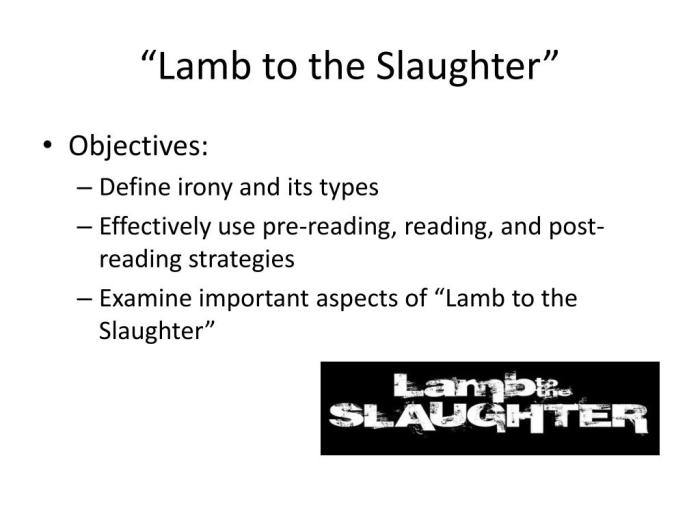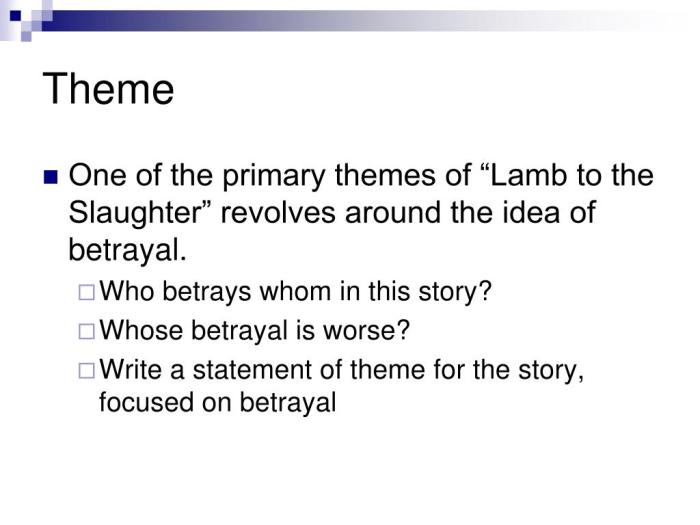Figurative language in lamb to the slaughter – Figurative language in “Lamb to the Slaughter” is a masterful literary device that elevates the story’s impact and resonance with readers. Dahl’s skillful use of metaphors, symbolism, irony, and foreshadowing enhances the narrative, creating a rich and multilayered experience that explores themes of violence, gender, and desperation.
Throughout the story, Dahl employs figurative language to reveal the characters’ inner thoughts and motivations, contribute to the overall atmosphere and tone, and foreshadow upcoming events. The result is a captivating and thought-provoking tale that has captivated readers for generations.
Figurative Language in “Lamb to the Slaughter”: Figurative Language In Lamb To The Slaughter

Roald Dahl’s “Lamb to the Slaughter” is a compelling short story that employs a rich tapestry of figurative language to enhance its narrative and explore profound themes. The story’s title itself, “Lamb to the Slaughter,” serves as a metaphorical allusion to the central character, Mary Maloney, and the events that unfold.
Metaphorical Meanings
The title “Lamb to the Slaughter” suggests the duality of Mary Maloney’s character. Initially portrayed as a gentle and unassuming housewife, she undergoes a transformative shift into a cunning and determined killer. The metaphorical representation of Mary as a “lamb” evokes her initial innocence and vulnerability, while the “slaughterer” refers to her newfound strength and ruthlessness.
This contrast underscores the story’s exploration of the nature of violence and the unexpected capacity for violence within seemingly ordinary individuals.
The use of animal imagery further contributes to the story’s meaning. The frozen leg of lamb that Mary uses to kill her husband symbolizes the act of violence itself. The lamb, a symbol of innocence and purity, becomes a tool of destruction, highlighting the irony and brutality of the situation.
Symbolism
The kitchen setting in “Lamb to the Slaughter” is a potent symbol of domesticity and violence. The kitchen, traditionally associated with nurturing and sustenance, becomes a scene of bloodshed and deception. This juxtaposition emphasizes the story’s exploration of the hidden violence that can lurk beneath the surface of ordinary life.
The use of light and shadow in the story also contributes to its atmosphere and foreshadowing. The initial scene is bathed in a warm, inviting light, creating a sense of domestic tranquility. However, as the story progresses, shadows begin to creep in, foreshadowing the impending violence and the darkness that lies within Mary Maloney.
Irony and Foreshadowing, Figurative language in lamb to the slaughter
Dahl employs irony and foreshadowing throughout the story to create suspense and build tension. The police officers’ initial reaction to Mary’s demeanor and actions is a prime example of dramatic irony. They assume she is innocent and incapable of violence, which makes her true nature all the more shocking.
Foreshadowing is also used to hint at the upcoming events. The mention of the frozen leg of lamb early in the story suggests that it will play a significant role later on. The officers’ casual conversation about their wives’ cooking foreshadows the fact that Mary will use her culinary skills to commit murder.
Character Development
Mary Maloney’s transformation from a seemingly innocent housewife to a cunning and determined killer is a central aspect of the story. Through the use of internal monologue, Dahl reveals Mary’s inner thoughts and motivations, providing insight into her psychological state.
The story explores the complex factors that contribute to her actions, including her desperation and the desire to protect herself.
Theme and Impact
“Lamb to the Slaughter” explores several central themes, including the nature of violence, the role of gender, and the consequences of desperation. The story challenges traditional notions of innocence and guilt, revealing the potential for violence within all individuals.
Dahl’s use of figurative language enhances the story’s impact and resonance with readers. The vivid imagery and symbolism create a lasting impression, leaving readers to contemplate the story’s themes and the complexities of human nature.
FAQ Compilation
How does the title “Lamb to the Slaughter” contribute to the story’s meaning?
The title foreshadows the story’s events, as Mary Maloney, initially perceived as a gentle and innocent “lamb,” transforms into a cunning and determined “slaughterer” who kills her husband.
What is the significance of the frozen leg of lamb?
The frozen leg of lamb symbolizes Mary’s domesticity and the violence she unleashes. It is both a weapon and a representation of the shattered illusion of her perfect life.
How does Dahl use light and shadow to create atmosphere and foreshadowing?
Dahl’s use of light and shadow reflects Mary’s inner turmoil and the impending doom. The initial warm and inviting light transforms into darkness, foreshadowing the violence to come.

